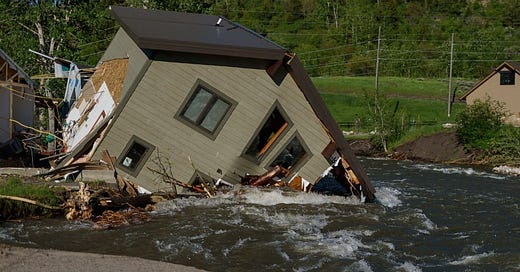Destabilized Saturday Edition #22
Federal judge turns on former clerks, "a nationwide paramilitary army," insane hail storm in Mexico City, and a New Mexico county previews 2024
This week in The five essential criteria for buying a climate-durable home that will appreciate in value, I explained how to distinguish climate durable homes from climate vulnerable ones. [I hope you’ll share the post with friends and family members who will be house-hunting in the coming years. It can save them considerable heartache, as well as a lot of money.] The post included the five key home durability factors:
Vulnerability to climate impacts
Population density
Wealth density
Willingness to raise taxes
Social capital strength
The first factor is the area’s and home’s degree of climate risk, and the other four factors describe the area’s capacity to adapt. In other words, we first have the magnitude of the problem facing a home and the place it’s located (climate vulnerability), and then we have the place’s ability to solve that problem (population density, wealth, willingness to raise taxes, and social capital).
Seeing it through this lens is clarifying. It reveals that if the problem is small and the capacity to solve it is large, that’s good. And if the problem is large and the capacity to solve it is small, that’s bad.
It follows that you should look for a home in a place where the climate problem (degree of risk) is smaller than the place’s ability to ruggedize against climate impacts (capacity to adapt). And the greater the gap between the two – call it the risk/adaptation margin of safety1 – the better the home’s value appreciation prospects.
You want to avoid, and be sure your friends and family know to avoid, homes where the capacity adapt is smaller than the climate problem.
The need to think this way is very new. Home-buying didn’t used to be this risky. But in the climate change era it is. Buying a home with a high level of climate risk and a low capacity to adapt may be the worst single financial decision anyone can make that doesn’t involve crypto. It will be emotionally devastating and economically ruinous for millions of families, leaving them with broken dreams and broken credit.
My Work
The five essential criteria for buying a climate-durable home that will appreciate in value
The ideal climate era home, then, is a climate durable property in a climate durable area, located in a well-off neighborhood with high levels of social capital, in a reasonably dense city or inner suburb, in a blue or blue-ish state that’s open to raising taxes to fund climate ruggedization.
Interesting Reads
Political divisions extend into Americans' friendships
Among Democrats, nearly 60 percent of core friend groups is made up of, well, other Democrats. About 8 percent of those groups are made up of Republicans and another 6 percent is made up independents.
The numbers for GOP core friend groups look very similar: Nearly 60 percent of their core friend groups is made up of other Republicans, about 9 percent are Democrats and another 7 percent are independents.
Tweets of the Week
Vice President Pence hiding from insurrectionists in the basement of the Capitol, watching Trump’s tweeted-out video praising the attackers. (Photo released by the January 6th select committee.)




Extreme Weather Watch



Creeping Authoritarianism Watch
Kathleen Belew, University of Chicago history professor and leading scholar of the white power movement.








Shout-out to the “father of value investing,” Benjamin Graham.









